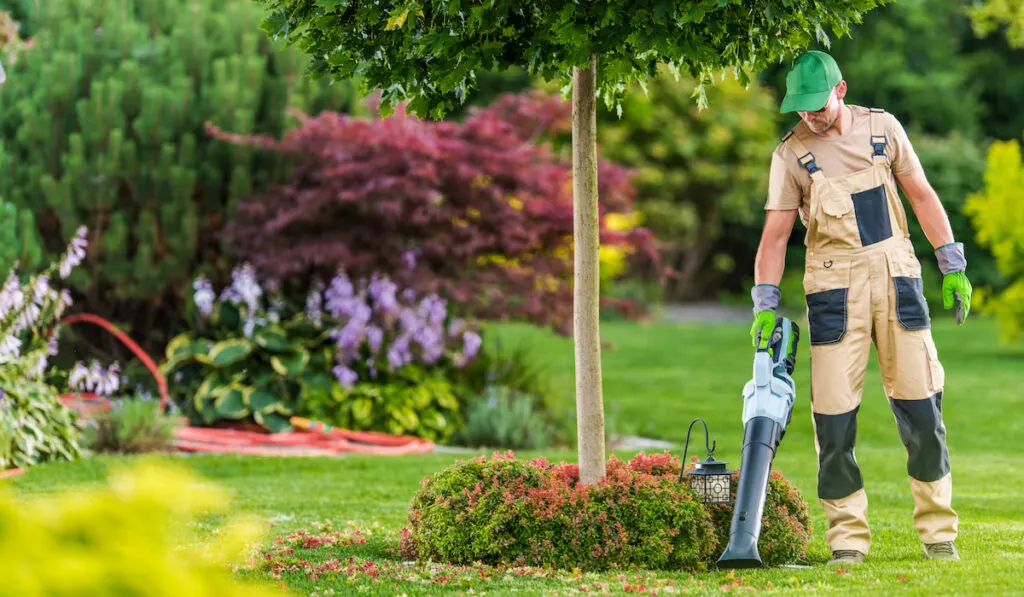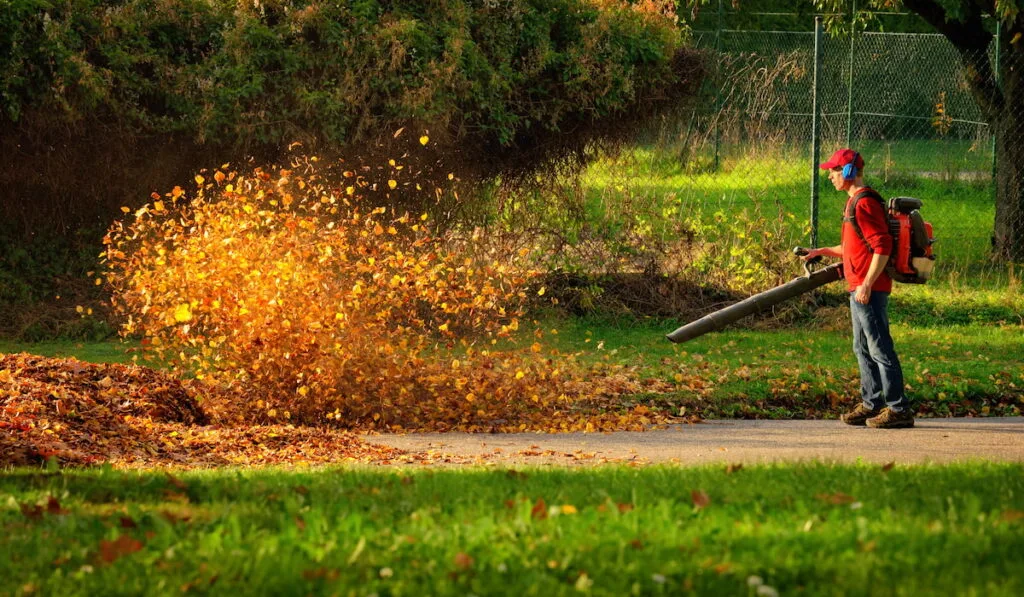*This post may have affiliate links, which means I may receive commissions if you choose to purchase through links I provide (at no extra cost to you). As an Amazon Associate, I earn from qualifying purchases. Please read my disclaimer for additional details.
Leaf blowers can change the game when it comes to fall leaf pickups in the yard. But if you’re new to the leaf blowing world, it can seem more like a challenge than a handy tool. Well, if you’re curious about using your leaf blower efficiently and effortlessly, then you need to know the tops tips and tricks to get you started- and finished.

How should I use a leaf blower?
Here are 11 tips for using a leaf blower successfully:
- Choose the Right Model
- Wear the Proper Safety Gear
- Know How to Rev Your Motor
- Use the Right Speeds
- Set Up a Single or Multiple Leaf Locations
- Handle it Properly
- Don’t Be Picky
- Use the Vacuum for Light Cleanups
- Avoid Wet Leaves
- Wait for a Calm Day
- Be Careful Around Flowers
If you’re ready to put your raking hassles to bed, then we welcome you to look at these 11 super handy tips and tricks for handling a leaf blower. With this valuable information, handling a leaf-ridden backyard will seem like a breeze, and you might find yourself wanting to help out your neighbor’s leafy problems, too.
Table of Contents
Top 11 Tips and Tricks to Use a Leaf Blower
Using your leaf blower just like a professional has never been easier. Simply follow these useful tips and tricks while you’re out in the yard and you won’t have problems when it comes to leaf pickups.
1. Choose the Right Model
There are three different types of leaf blowers to choose from. Finding the right model is imperative to success. After all, smaller yards won’t require nearly as much energy or power behind them, so finding a model that suits the size of your yard as well as how many leaves you come in contact with will save you time and money.

There are the types to pick from:
- Handheld blower. These blowers are not too powerful and are ideal for small spaces and yards.
- Backpack blower. Placed directly on your back like a regular backpack, this model is ergonomic and easy to use, albeit a bit heavy. They are best for larger-scaled jobs as they are more powerful than handheld models.
- Push leaf blower. Mostly used for commercial properties and huge areas, push leaf blowers not usually used by homeowners because of their power.
2. Wear the Proper Safety Gear
Safety first! Leaf blowers are loud, and they can easily blow sticks and rocks into your eyes if you’re not careful. It’s imperative that the person operating the leaf blower always wears a pair of goggles and earplugs.
3. Know How to Rev Your Motor
There are two types of leaf blowers: electric and gas. The electric models are going to be a cinch to start-simply plug it in and turn it on, and the leaf blower is ready to go. Gas-powered leaf blowers, on the other hand, may present a bigger challenge.
As noted in by Sean Brendlinger, you will want to start by pressing the bulb on your leaf blower a few times (3-6 times should do the trick). (source)
Double-check to make sure that there is gas in the leaf blower and that the equipment is turned on, then pull on the starter rope. If you don’t have success after 10 tries, let the device rest for 10-15 minutes before trying again.
4. Use the Right Speeds

A lot of leaf blowers come with differing speeds. Lower speeds should be used on areas where there are not a whole lot of leaves present, as too much power might send them flying in directions you did not intend them to go. More power should be utilized in dense areas.
The speed, or power, required will also be highly dependent on the type of surface you are trying to clear leaves from. It is immensely easier to clear dry leaves from dry concrete, for example, than it is to clear damp leaves from overgrown damp grass.
5. Set Up a Single or Multiple Leaf Locations
It might be tempting to blow all of the leaves to the middle of your backyard, but this could be more difficult, says Jeremy Delores (source).
While this is an acceptable plan to use while leaf blowing, you have a better chance at success by dividing up your garden into multiple leaf collecting locations.
You will want to make sure that the area, whether a single area or multiple spots, has a tarp or some type of covering to place the leaves. That way, you can scoop up the tarp, toss the leaves (or place in a compost bin or pile), and be done with your job.
6. Handle it Properly
There’s a technique to using your leaf blower the ‘right’ way. You want to make sure that the leaf blower is down to your side and that there is a very shallow angle upwards.
Too little angle and you won’t get any of those pesky leaves moving, and too much angle can leave you with leaves flying every which way.
Once you have the leaf blower placed strategically, simply walk forward slowly and move the leaf blower left to right to pick up the leaves in your way.
Remember that you should be pushing the leaves in a single direction, either towards a single tarp in the yard or multiple ‘leaf locations’ that will be disposed of later.
This video offers a great visual on how to properly place your leaf blower.
7. Don’t Be Picky
It’s important to remember that your leaf blower isn’t a superhero, and there may be a few rogue leaves leftover.
Don’t be mad, though.
The leaf blower is designed to get the bulk of the leaves. Simply run a rake over your yard or pick up the extra leaves by hand- it should only take a few minutes thanks to your leaf blower’s mass job.
8. Use the Vacuum for Light Cleanups
A lot of leaf blowers offer vacuums as well; however, the vacuum feature should only be used for light pickups. If there are just a few leaves scattered in the yard or you notice some inside of cracks that can’t be reached with a rake, you can use the vacuum method.
This method, though, should not be used for the entirety of your yard. As David Beaulieu points out, vacuums simply don’t have the sucking power to handle a large number of leaves. (source) It’s counterproductive to try and handle all the leaves with the vacuum.
If you routinely need to clear a small number of leaves, a dedicated leaf vacuum may also be a great addition to your tool kit.

9. Avoid Wet Leaves
Have you ever tried to rake up wet leaves? It’s nearly impossible. And while you might think that your leaf blower has the power to handle wet leaves, think again.
While you might be able to find some success using the highest speed and power on your leaf blower to handle wet leaves, your best bet is to wait until the leaves have dried completely.
After all, why would you want to make your job more challenging and stressful? You will save time and energy by simply waiting until the rainstorm has passed, and the leaves have dried up.
10. Wait for a Calm Day
Picture it- you’re trying to use a leaf blower to blow leaves to the northeast corner of your yard, but the wind is blowing in the opposing direction. It’s a recipe for disaster- a leaf hurricane, to be exact.
If you can’t use the wind to work for you, it’s best to wait until the wind is gone altogether.
11. Be Careful Around Flowers
Flowers can quickly become damaged by the powerful force of a leaf blower, so it is best to stay away from them altogether.
Not only that, but any type of mulch or soil that’s on your flower garden can end up being sprayed across your lawn, which equates to a lot more work on your part.
Conclusion
Getting rid of all those pesky leaves in the backyard can be a challenge, but when you know how to use your leaf blower correctly, it will be less of a challenge. Follow these handy tips and tricks, and you will be able to conquer your fallen leaves.
